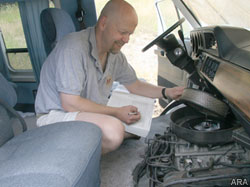
(ARA) – Which is cheaper – a monthly car payment for a new vehicle that will almost certainly have lower maintenance and repair costs than an older car? Or keeping on top of regular maintenance and repair of an older car, and saving yourself the monthly car payment?
If the numbers are any clue, it would seem more Americans believe holding on to an older car costs less than paying for a new one. The average age of passenger cars is now more than 9 years, according to data from R.L. Polk. And the average price of a new car tops $28,000, according to the Federal Trade Commission. What’s more, older cars depreciate less and often cost less to insure.
Hanging on to a car – and taking care of it – can definitely save you money versus taking on a new-car payment. The key to maximizing your savings on an old car is actually to spend a little on regular maintenance. That will allow you to avoid more costly, emergency repairs caused by the breakdown of poorly maintained parts.
Follow these simple steps to ensure good maintenance helps you avoid expensive repairs:
1. Get to know the owner’s manual. Your owner’s manual will provide vital information on your vehicle’s systems, and should include a maintenance schedule. If you no longer have the owner’s manual or want more detailed maintenance information for your car, you can buy a factory service manual online. Auto parts retailer RockAuto.com sells manuals for $12 to $50 – money well spent if it helps you avoid a repair that costs hundreds or even thousands.
2. Take care of the timing belt. Most cars newer than 20 years old have timing belts that need to be changed, sometimes as often as every 60,000 miles. When the timing belt breaks it may either simply leave the car immobile or, worse, if the car has what the RockAuto.com auto parts catalog calls an “interference engine,” then a broken timing belt will likely cause expensive damage to other engine parts. Look in your owner’s manual to see if your car has a timing belt and when it must be replaced.
3. Check your fluids. Make sure you know the manufacturer’s recommendations for what type of oil, antifreeze, transmission, power steering and brake fluid your vehicle uses. Using outdated or the wrong fluid can cause damage – and void any remaining warranty on your car. Check your owner’s manual to determine what kind of fluid to use and when each needs to be changed.
4. Pay attention to shock absorbers and struts. These parts protect the suspension, steering, brakes and other vehicle systems. Waiting until the car starts to ride funny or bounce before replacing the shocks and struts may cause costly damage to other parts. Plus, a car that handles and stops poorly is less safe. Monroe.com presents a strong case for replacing original shocks and struts on most popular cars at 50,000 miles. Consult your service manual or mechanic to get recommendations for your specific vehicle.
5. Stay on schedule. The maintenance schedule in your owner’s or shop manual will also list important inspections to perform periodically, and repairs or maintenance you can expect the vehicle will need throughout its serviceable life. It will often be cheaper to replace auto parts before they break than after. Use the chart in your manual to keep track of completed maintenance.
Performing regularly scheduled maintenance also will allow you to anticipate expenses and budget for them – a tactic which will always save you more money than paying for emergency repairs.





